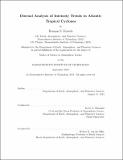Diurnal analysis of intensity trends in Atlantic tropical cyclones
Author(s)
Kowch, Roman S
DownloadFull printable version (4.246Mb)
Other Contributors
Massachusetts Institute of Technology. Department of Earth, Atmospheric, and Planetary Sciences.
Advisor
Kerry A. Emanuel.
Terms of use
Metadata
Show full item recordAbstract
I postulate that a diurnal cycle may exist in observational variables related to tropical cyclone (TC) intensity. Prior studies document a significant diurnal signal in moist convection across tropical regions. Since convection becomes more pronounced in intense TCs, daily solar insolation possibly affects observed TC intensities. What remains unclear is if the diurnal signals in physical influences, or factors that modulate TC intensity over hourly timescales, are also prominent in observed TC intensity fields. We apply various analytical techniques to two TC datasets and uncover a slight, yet detectable, diurnal trend in some calculated intensity fields. We first calculate 6-h maximum sustained surface wind (MSSW) tendencies using Atlantic TC best-track data from the National Oceanic and Atmospheric Administration (NOAA) National Hurricane Center (NHC) over years 1967-2011. In addition, we separate land tracks from warm-water tracks to analyze diurnal departures from the background states of these physical situations. We obtain a mid to late morning maximum in rapid intensification (RI) events over warm water. No discernible trend exists for land-filling TCs, even after using the decay model of Kaplan and DeMaria (1995) to find diurnal departures from mean decay rates. We also calculate theoretical TC indices using Atlantic TC dropsonde data from NOAA NHC over years 2002-2005 and 2011-2012. The indices, which measure physical influences on TC intensity, shift significantly during morning hours. This trend includes higher potential intensity (PI) and lower ventilation during late morning. The diurnal signal in RI frequency and intensity indices follows prior statistics and two physical mechanisms. The signal's greater PI coincides with more frequent occurrences of RI events, as confirmed statistically for Atlantic TCs by Kaplan and DeMaria (2003). Data noise likely obscures a possible diurnal signal in the negative MSSW tendencies analyzed in our study. Large-scale mechanisms that support our observed diurnal signal include enhanced radiatively driven low-level convergence and mid-level moisture during morning hours.
Description
Thesis (S.M. in Atmospheric Science)--Massachusetts Institute of Technology, Dept. of Earth, Atmospheric, and Planetary Sciences, 2013. This electronic version was submitted by the student author. The certified thesis is available in the Institute Archives and Special Collections. Cataloged from student-submitted PDF version of thesis. Includes bibliographical references (pages 79-84).
Date issued
2013Department
Massachusetts Institute of Technology. Department of Earth, Atmospheric, and Planetary SciencesPublisher
Massachusetts Institute of Technology
Keywords
Earth, Atmospheric, and Planetary Sciences.